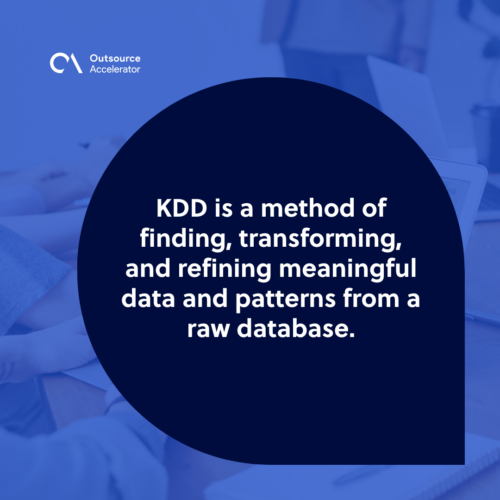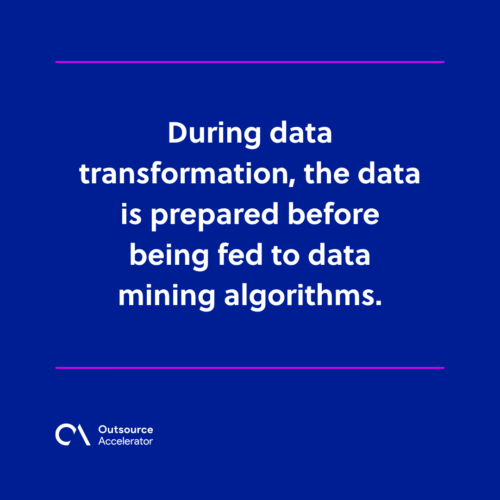KDD process: What you need to know

The manual process of extracting patterns from data has transpired for centuries.
The continuously enhancing power of technology has dramatically improved the data collection, storage, and manipulation ability.
Datasets have been growing both in size and complexity. Due to this, direct data analysis has progressively augmented with indirect and automated data processing.
Data mining is the process of applying the methods mentioned above. This intends to reveal hidden patterns in huge sets of data.
Data mining procedure bridges the gap between applied statistics, artificial intelligence, and database management. Along with data mining comes the concept of the KDD process.
Read this article to explore further the concept of the KDD process and the steps usually involved in it.
What is the KDD process?
Knowledge Discovery in Database (KDD) is the vast process of discovering knowledge in data.
KDD is a method of finding, transforming, and refining meaningful data and patterns from a raw database. These enhanced data sets are to be used in different domains or applications.
It comprises an organized procedure of extracting valuable, previously unknown information from large and complex sets of data. This is accomplished by using data mining algorithms.

KDD vs. Data mining
The term ‘data mining’ is often substituted for ‘KDD’ and vice versa. However, they have their distinctions, as you will learn below.
KDD involves the evaluation and interpretation of the patterns discovered to decide on what qualifies as knowledge.
In the KDD process, data can undergo encoding schemes, preprocessing, sampling, and projections before proceeding to data mining.
KDD aims to recognize hidden patterns and relationships in data that can be used to make decisions, recommendations, and predictions.
Data mining, on the other hand, refers to the application of algorithms for extracting patterns from data. This is done without the additional steps involved in the KDD process.
Data mining is the root of KDD and is a key component of the whole method.
Stages of the KDD process
Prior knowledge is a general prerequisite to the entire process. One must have a sufficient understanding of the field in which the KDD process is to be applied. If not, the procedure can lead to false interpretations.
The steps involved in KDD are as follows:
Data integration
Data integration involves combining data from multiple relative sources. This procedure uses data migration, synchronization tools, and the Extract-Load-Transform (ETL) process.
Data selection
This step consists of deciding which data is relevant and retrieving them from the whole collection. During data selection, a focus is set on attribute subset selection and data sampling. This aims to reduce the number of records to be used in the subsequent stages.
Data cleaning and preprocessing:
This stage eliminates unwanted data, particularly noisy, inconsistent, repetitive, and low-quality ones. Algorithms are used for searching and removing undesirable data based on specific attributes.
The purpose of this step is to improve the remaining data’s reliability and effectiveness.
Data transformation
During data transformation, the data is prepared before being fed to data mining algorithms. The data needs to be consolidated (based on functions, attributes, and features) and aggregated.
Data mining
This stage is the backbone of the whole KDD process.
In data mining, algorithms are used to extract valuable patterns from the transformed data.
Techniques such as artificial intelligence (AI), advanced statistical methods, and specialized algorithms are used to accomplish this step.
Pattern evaluation/interpretation
Pattern evaluation entails identifying increasing patterns representing knowledge based on given measures.
This is done to study the impact of the data collected and transformed in the preceding stage. It also makes the data digestible for the user.
Knowledge representation
Upon obtaining the patterns from various data mining methods, they need to be represented visually. They can be interpreted using bar graphs, pie charts, or other types of visual data representation.

Why the KDD process is important
Data mining can help solve business problems through data analysis. Techniques and tools involved in it allow companies to predict future trends and make well-informed decisions.
KDD is a broad and interdisciplinary field utilized in different industries, including finance, marketing, healthcare, and e-commerce.
It is an important and helpful asset for companies because it enables them to acquire new insights and knowledge from their data.
By using KDD, you can improve your organization’s decision-making, strategic planning, and business processes and optimize your operations.
The KDD process can also ultimately contribute to a better customer experience as well as your business growth.







 Independent
Independent




